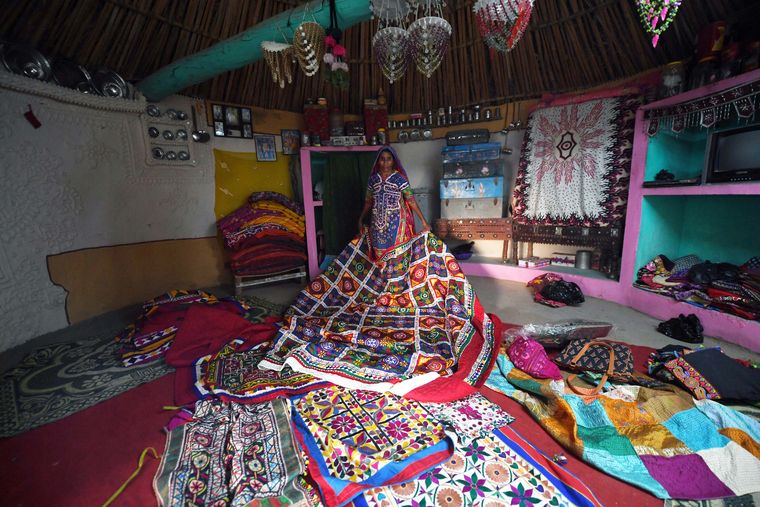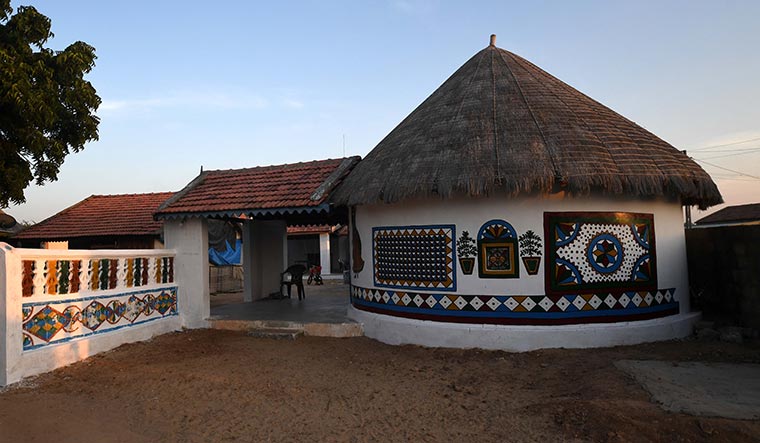Rabari Manju could very well be a spy.
The 23-year-old is on a secret mission in her village in central Kachchh, Gujarat, and has already prevented 20 child marriages. Discreetly.
“I keep an eye out for freshly printed wedding cards circulating in the villages,” she says. “If it is going to be held in the fields, then it is most likely a child marriage. I immediately alert the authorities.”
She also collects information about girls who have dropped out of school and tries to persuade their families to let them continue their education. “Sometimes, I face hostility, but I try my best,” she says.
Manju’s mission is as much a social initiative as it is personal. She does not want another girl to have an experience like hers. She was betrothed to a boy when she was two years old in a custom called saata baata, where her brother was betrothed to her fiancé’s sister. Later, her schooling was cut short as her fiancé, too, was in the same school.
Manju belongs to a pastoral community where child marriages, though illegal, are fairly common. And, it is a practice prevalent across villages in Kachchh. In Bhadroi village close to Anjar town, ten teenaged girls are attending classes at an anganwadi where the Kutch Mahila Sanghatan is running a learning centre. Almost all of them are dropouts, and married. Some were betrothed when they were just three.
Though shy in the beginning, the girls start talking about child marriage. “This practice is wrong,” says Sita, 17 (name changed). “We want to choose our husbands.” Almost all the other girls nod in agreement. Says another girl. “We don’t have the courage to oppose our parents now. But the dialogue has started and hopefully the future will be better.”
Meghwal is a dominant community in the region known for its Pakko embroidery, using mirrors. But no embroidery, however pretty, can patch the patriarchal blind spots that exist in the community. There is an unofficial ban on photographing unmarried or young women of the community. “Earlier, local women used to happily pose for photos, without any objection,” says a trader. “But because of social media, all photos clicked by tourists immediately go online with hashtags and geotags. Families were worried that the pictures could be misused. Also, men of marriageable age objected to seeing their prospective brides’ photos in public domain.”
In the northern part of Kachchh is a verdant stretch, the Banni grasslands spread over 25 lakh hectares. It is a unique landscape where wildlife thrives, as do human settlements. The women here carry with them a pop of colour, threaded intricately into their traditional embroidered top and skirt. The homes―earthen, circular with thatched conical roofs―are called Bhunga. But there are only a few traditional Bhungas left; most are now made of bricks and tiles and are rented out as homestays or put on display for tourists.
Khammo, 75, lives in a traditional Bhunga in Bhirandiyara village. Eighteen members of his family live in half a dozen Bhungas next to his with their livestock. The houses are fenced in using sticks and branches of trees.
Khammo’s two-decade-old Bhunga just has a room, but it brims with character. The walls are clothed in mirror embroidery and carvings. On one corner stands a ‘natural’ fridge, made of mud, with edible items stored inside. A window lets in light; a locker keeps its contents dark. Clothes, utensils and other belongings find their place on different mud shelves on the wall. The Bhunga keeps its inmates cool during summer and warm during winter; the slanted roof helps during monsoon.
A few kilometres away in Ludia village, Naveen Sawamwar, 20, and his family have turned their Bhungas into studios to sell their products. They make clothes in Pakko embroidery, towels, bed sheets, key chains, earrings and other handicrafts. Pakko embroidered clothes take months to make, says Naveen.
Girls in the community start stitching their wedding dresses at a young age. “Some may take 15-20 years and some may take a few years,” says Naveen’s brother Heerabhai. “On the day of the wedding, they wear the dress they have been stitching.”
Ask him to show his wife’s wedding dress, and he says, “That’s not with us anymore. An English lady loved it so much that she paid Rs40,000 for it.”
Every community in Kachchh has a distinct style of embroidery. Jeevaben, in her sixties, is recognised in Bhadroi for her embroidery skill. She shows off her wall hangings in dark colours and a distinct asymmetric pattern. It takes her seven to eight months to make one piece, she says, and she sells it for Rs30,000 to Rs40,000. She, however, worries that the art form is dying, as the younger generation is not too keen on carrying forward the legacy.
While it is a valid worry, women in Kachchh today seldom want to stay home, tied to traditions. Take, for instance, Chandni Bharat Parma, 22, the first woman to drive an auto-rickshaw in Bhuj town. She effortlessly manoeuvres the rickshaw through traffic and crooked lanes. She was only 18 when she decided to take up driving and be financially independent.
“My relatives and others in the neighbourhood reprimanded my family for allowing a girl to step out and drive a rickshaw,” she says. Her mother-in-law, too, gave her an ultimatum, but she remained unfazed.
“I am perfect in my eyes,” she says. “Even if it is just my family and a few others who support me, that is fine. I have also resumed my studies. Some of my friends did not even study till class ten.”
But her passengers, most often, have been kind and encouraging. Some wish her the best; while some others tell her, “Desh ka vikas ho raha hain (the country is progressing).” The daughter of a heavy vehicle driver, Chandni now wants to be the first woman to drive a bus in Bhuj.
This drive to do better is quite visible in Kukuma, one of the few villages on the outskirts of Bhuj, which boasts a balika panchayat that works towards the welfare and literacy of young girls. The Gujarat government introduced this parallel panchayat aimed at girls aged between 11 and 21, who can elect their sarpanch and ward members. Close to 600 girls elected Urmi Ahir, a final year science student, as the sarpanch. Every month, Ahir and ward members head to the panchayat office for a review meeting.
Ahir believes in the power of democracy and loves the respect she is getting as a sarpanch, which also makes her feel responsible. She proudly says that in her village, names of girl children are mentioned on the nameplates outside their houses. Also, girls who complete their education get prizes and free transport. Ahir recently conducted a women’s cricket tournament.
“I want to be the sarpanch of my village,” she says. After a pause, she adds, “Who knows, after that, I may want to become an MLA or an MP.”
The women of Kachchh have not shied away from politics. Nimaben Acharya, the first woman speaker of the Gujarat assembly, was from Kachchh. There were three women among the six MLAs from Kachchh in the last legislature, including Nimaben. Now there is only one.
Poonamben Veljibhai Jat was elected MP from Kachchh in 2009. “When I entered Parliament, there were only a few women MPs from Gujarat,” she says. “Today, there are a lot more. But, as a woman, I feel it is not enough. A vase will be beautiful if there are different types of flowers. Similarly, women from different communities and regions should also be there.”






